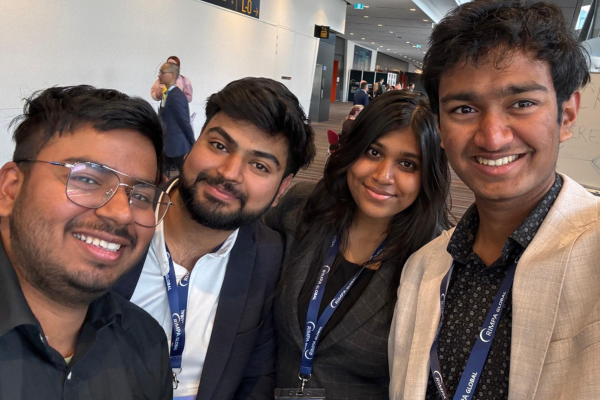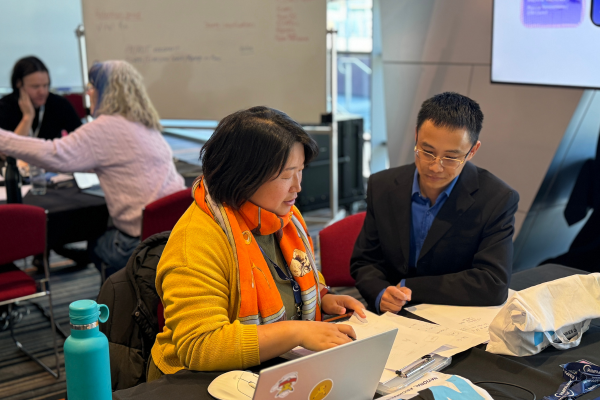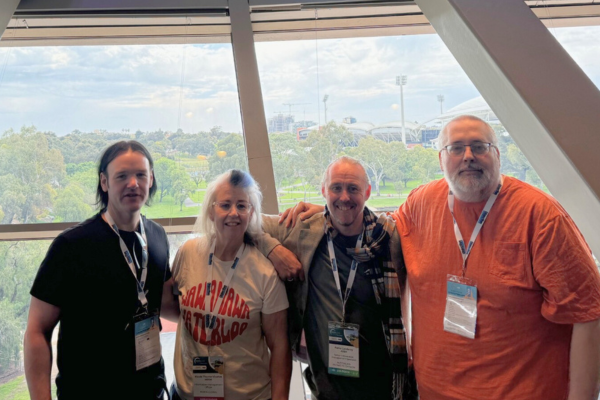IM Blog: What was it like participating in a Hackathon?

TEAM: Something Nerdy
Team Members: - Isumi Wanigasekara, Keshav Chauhan, Saibhaskhar Ramesh and Anjal Rai
Our Pitch: We developed a formula to assign value to information, allowing businesses to recognise it as an asset on their balance sheets. This approach emphasises the strategic importance of data within an organisation.
What We Learned/Enjoyed: Participating in the hackathon was an enriching experience for our entire team. We learned how to collaborate effectively under pressure and gained valuable insights from industry professionals. Although we didn’t win, the feedback we received was incredibly motivating. It was a pleasure working together, and we truly enjoyed preparing our presentation. Additionally, we were fortunate to make some meaningful connections that will benefit us in the future.

TEAM: Guruwari
What was the pitch that your team came up with?
'Record' is a noun and a verb. The dynamic character of records and information in holographic displays is beyond bar charts and Excel sheets.
Through tangible and vivid examination of large holographic displays created by intelligence software at a hall of a quarter of a Bunnings store, information managers notice that incomplete and poor datasets and information generate non-enjoyable holographic results. In contrast, quality information enables the managers to experience the information similar to at Van Gogh Alive where they walk around the hall and immerse in the large moving displays. In terms of information management, the intrinsic value is different from art - the value is shown in holographic displays which either reenact the environment in the past (the streetscape of a CBD or a particular allotment of a suburb where you walk along the street or into the allotment) or predict the future for decision making (residents' reaction to the government's road projects or high-rise apartment's building noises and work zone closure impacts on the catchment area where you see emotional residents disagree with the decisions or are disturbed by the building noises) based on the information and trends.
Abandoning top-down and button-up theories where human resistance hinders even the simple basic information asset registers of an organisation, our team considers that an intelligence tool, like a truffle-sensing dog, that sniffs and brings back information from devices to the intelligence software leads to holographic results which are beyond the imagination of bar charts or Excel worksheets. A step further, organisations collaborate and benchmark their information against others in the holographic hall by analysing whether the displays reference their information because the intelligence software acknowledged the quality, quantity and value of their organisational information, and removing their organisational information and seeing what display details suddenly go missing.
Our team name Guruwari means seeding in an Australian indigenous language. I hope this brave proposal brings emotion to organisation decision-makers when they stand in the holographic hall so that they know what good information they possess and what information the intelligence software does not bother referencing.
What did you enjoy/ learn about participating in the Hackathon?
Hearing stories about how winners of other hackathons presented their ideas.

TEAM: Tropicop Hacktivists
Members: Nicole Thorne-Vicatos, Kemal Hasandedic, Shelley Caravazan, Ryan Delaney and Farnz Corderoy.
What was the pitch that your team came up with?
Information practitioners are in every organisation regardless of what your position title is, so our approach was to provide several tools that could be modified to suit the purpose or capacities of each organisation. Our digital model was an AI algorithm that determined the dollar value of the assets and also a description that could be used to garner Executive support. An Excel solution was created for workplaces wanting a simpler approach that could be tailored to your legislative, regulatory, risk assessments or business needs. Both options allow users to apply a value score to all of your information/data assets. Weight those scores ( Historical, Societal, Financial, Legal, Business, Privacy) against the organisation’s business imperatives. We developed an Information asset register, IM risk criteria, Value scoring criteria and a Dataset valuation framework. Our presentation was built around the real-life example of NASA using Australian Antartic Division remote health records of polar expeditioners (77 years) to understand the potential medical situations for future Mars scientists.
What did you enjoy/ learn about participating in the Hackathon?
Meeting the fantastic students putting their young, fresh minds to a situation they will be exposed to soon. Getting to discuss a strategic issue with other IM professionals – we are too often just caught up with operational issues.

TEAM: Hacks of Random Kindness
Members: Machelle Tennent, Alicia Slamkovic, Louise Curham, John Cox and Debra Menzies
The winning team, proposed a forecasting model based on deep industry experience in the team and fresh student perspectives. The team is working with RIMPA Global and NAA to use the prize money to set up a research and education fund and development their winning idea.
So what was the idea?
Machelle gave a brilliant presentation ‘Where to invest money, forecasting information value’. Machelle set the team off in the right direction, ‘our idea had to be feasible and it had to build on some of the resources we already have in the IM community, like information asset registers and access to finance and accounting people in our organisations.’
Cost is fact, value is opinion
Louise said the team thought about what makes information different from other assets. It has a fixed cost, so for example databases can be costed as nuts and bolts but their worth is subjective – different people perceive that worth that differently. Machelle helped the team draw on accounting ideas of the differences between objective cost or what she called factual cost, and subjective cost - in other words, value. Machelle explains, ‘the factual cost is that the item costs $2. The subjective cost is the value - I believe it’s worth $20.’
Random Hacks of Kindness agreed that information assets are not obvious on balance sheets. As Machelle said, ‘that line items for ‘information assets’ are missing, therefore information is not valued in the same way as other assets. If assets are visible, that means they can be strategically valuable, part of the forward planning for an organisation.’
So the team worked on two problems: improving how IM teams work with accountants and finance teams to get objective costs for information assets more visible; and the subject side, value. The team proposed a value matrix across, including measures like protection value, human dignity value and carbon reduction value. Michelle explained, ‘our sector is good at static information and current value. We have room to improve in future and strategic value. We’re not good at taking on board the way value can change from political, social and economic factors for instance.’
Hacks of Random Kindness proposed a dashboard style reporting tool that provides dynamic forecasts of information value over short and medium time frames. The idea is that one month, six month, 12 month forecasts of information value will help decision makers ensure appropriate investment.
TEAM: On Da Fence
Members: Malcolm Lambeth, Jenelle Hitchens, Ben Wilkinson and Nigel Eggins
What was the pitch that your team came up with?
Increasing engagement and curiosity in data. Asset - A Simple Solution for Engagement. How we can use AI such as that used in Spotify to customise data queries? With better engagement comes more understanding.
What did you enjoy/ learn about participating in the Hackathon?
Brainstorming within our team. Got our minds working together, in a fast-paced collaborative environment.
Interested in participating in the 2025 Hackathon?
The Hackathon Challenge by RIMPA Global, sponsored by the National Archives of Australia is back in 2025.
Do you think you’ve got the skills to solve one of the biggest challenges in information management? Gather your team, unleash your creativity, and compete for $10,000 AUD in the RIMPA Global Hackathon 2025!
The Challenge- this is the question: How can organisations reduce the carbon footprint of their information management practices to promote sustainability?
Why join?
- Win $10,000 AUD
- Get industry recognition and global exposure
- Connect with mentors, experts, and potential employers
- Build your skills through real-world problem-solving
Event details:
- Public Record Office Victoria & RIMPA Live Convention 2025, Melbourne
- FREE to register
